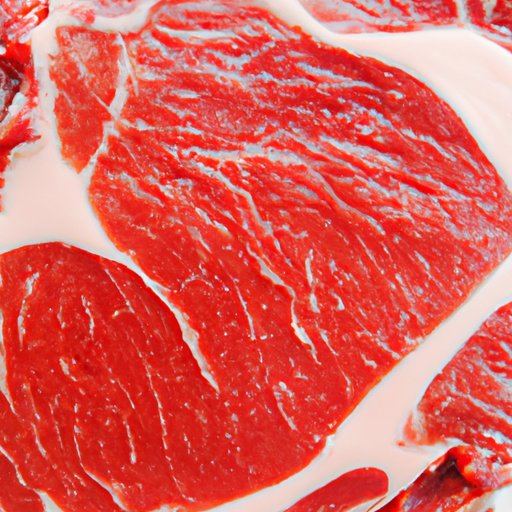
Introduction
Red meat is a dietary staple for many people, providing a delicious and satisfying source of protein. However, in recent years, there has been growing concern about the health implications of consuming red meat. Some studies have linked high red meat consumption to an increased risk of heart disease, cancer, and other health problems. But does this mean you should eliminate red meat from your diet altogether? In this article, we will explore the pros and cons of red meat consumption, the science behind optimal intake, and guidelines for safe and healthy consumption.
Pros and Cons of Red Meat Consumption: How Often Should You Eat It?
Red meat is a great source of protein, zinc, and iron, which are essential to a balanced diet. However, it is also high in saturated fat, which can contribute to heart disease and other health problems. The key to safe and healthy consumption of red meat is moderation.
According to the American Heart Association, you should limit your consumption of red meat to no more than three ounces per day, or about the size of a deck of cards. Additionally, it is important to choose lean cuts of meat, such as sirloin, tenderloin, and flank steak, which are lower in saturated fat. Processed meats, such as bacon, sausage, and hot dogs, should be avoided or consumed in very small amounts, as they are high in sodium and other additives that can be harmful to your health.
The Science Behind Red Meat Consumption: A Guide to Optimal Intake
Red meat is a nutrient-dense food that is rich in essential amino acids, vitamin B12, and iron. It is a great source of protein that provides your body with the building blocks it needs to repair and maintain muscle tissue, as well as to produce hormones, enzymes, and other important compounds. However, red meat is also high in cholesterol and saturated fat, which can contribute to heart disease and other health problems if consumed in excessive amounts.
Current dietary guidelines recommend that adults consume between five and six and a half ounces of protein per day, depending on factors such as age, sex, and activity level. However, it is important to choose protein sources that are high in nutrients and low in saturated fat. Red meat can be a healthy part of your diet if consumed in moderation, alongside other sources of lean protein such as poultry, fish, beans, and nuts.
Red Meat and Health: Understanding the Impact of Frequency of Consumption
Research has linked high red meat consumption to an increased risk of several chronic diseases, including heart disease, cancer, and diabetes. However, it is important to note that the research is not yet conclusive, and there are many factors that can contribute to these diseases. For example, individuals who consume high amounts of red meat may also smoke, drink alcohol, and have a sedentary lifestyle, which can all impact their health in negative ways.
Current dietary guidelines recommend that adults consume no more than 18 ounces of red meat per week, or about three ounces per day. However, it is also important to choose lean cuts of meat and to avoid processed meats, which are higher in saturated fat and harmful additives. If you are concerned about the health implications of red meat consumption, you may wish to talk to your doctor or a registered dietitian for further guidance.
The Role of Red Meat in a Balanced Diet: Guidelines for Safe Intake
Red meat can be a healthy addition to a balanced diet when consumed in moderation. It is a great source of high-quality protein, iron, and other nutrients that are essential for good health. However, it is important to choose lean cuts of meat and to avoid processed meats, which can be harmful to your health if consumed in excessive amounts.
When incorporating red meat into your diet, it is important to balance it with other sources of lean protein such as poultry, fish, beans, and nuts. You should also aim to consume plenty of fruits, vegetables, whole grains, and other plant-based foods, which provide important vitamins, minerals, and fiber. This will help to ensure that you are getting the nutrients your body needs while minimizing your risk of chronic diseases.
Red Meat vs. Plant-Based Alternatives: Is There a Sweet Spot for Consumption?
Plant-based protein sources such as beans, lentils, tofu, and nuts can be a healthy alternative to red meat. They are typically lower in saturated fat and higher in fiber and essential nutrients. Additionally, replacing red meat with plant-based protein sources may have positive effects on your overall health.
However, it is important to note that not all plant-based protein sources are created equal. Some plant-based foods, such as coconut oil and palm oil, are high in saturated fat and should be consumed in moderation. It is also important to ensure that you are consuming a variety of plant-based protein sources to ensure that you are getting all of the essential amino acids your body needs.
Conclusion
In conclusion, red meat can be a healthy part of your diet when consumed in moderation. It is a great source of essential nutrients such as protein, iron, and vitamin B12. However, it is important to choose lean cuts of meat and to avoid processed meats, which can be harmful to your health. Additionally, it is important to balance your red meat consumption with other sources of lean protein, as well as fruits, vegetables, and whole grains. If you have concerns about your red meat consumption or are looking to make dietary changes, you may wish to talk to your doctor or a registered dietitian for further guidance.





